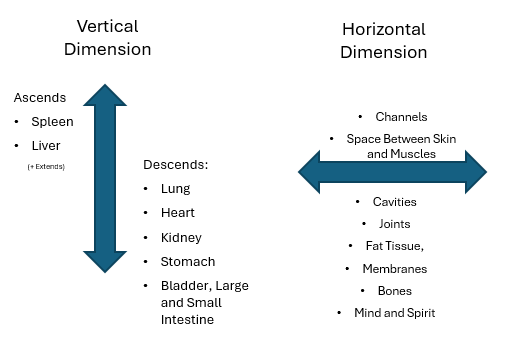


Qi Dyanmic
The Qi dynamic in Traditional Chinese Medicine (TCM) encompasses the various activities, processes, and changes of Qi that occur throughout the body. These activities are essential for maintaining health and balance. The critical aspects of the Qi dynamic include:
-
Metabolism: Qi plays a vital role in the body's metabolic processes, including transforming nutrients into energy and synthesising essential substances needed for cellular functions.
-
Movement: Qi circulates throughout the body via the meridian system, providing energy and vitality to all organs, tissues, and structures. Smooth and unobstructed Qi movement is essential for maintaining health and preventing disease.
-
Direction: Qi flows in specific directions within the body, following the pathways of the meridians and channels. Proper direction of Qi flow is necessary to ensure the normal functioning of organs and tissues.
-
Transportation: Qi transports nutrients, oxygen, and other essential substances to various body parts, ensuring proper nourishment and function.
-
Transformation: Qi undergoes constant transformation, converting from one form to another to support different physiological processes and activities.
-
Transmutation: Qi can change its quality or nature in response to internal or external influences, adapting to the body's needs and environmental conditions.
-
Condensation: Qi can condense or concentrate in some body regions, such as the Dantian or acupuncture points, to enhance its therapeutic effects or support specific functions.
-
Excretion: Qi also plays a role in the excretion of waste products and toxins from the body, helping to maintain internal cleanliness and balance.
The Qi dynamic reflects the dynamic nature of Qi within the body and its essential role in supporting life, health, and vitality. By understanding and harmonising the Qi dynamic, practitioners of TCM aim to promote wellness and effectively treat various health conditions.

Qi Dynamic

The Smooth Flow of Qi
In Traditional Chinese Medicine (TCM), the smooth movement of Qi is essential for maintaining health and preventing disease. This movement relies on the balanced flow of Qi entering and exiting various structures and energetic layers within the body.
-
Qi Entering (Going In): Qi enters the body through various channels, including the respiratory system (through breath), the digestive system (through food and drink), and the skin (through environmental influences). Once inside the body, the meridian system distributes Qi to the organs, tissues, and structures.
-
Qi Exiting (Moving Out): After Qi has performed its functions and nourished the body's organs and tissues, it exits the body through various pathways. This may include the elimination of waste products through the respiratory system (exhalation), digestive system (urination and defecation), and the skin (sweating).
Qi moves within the physical body and among different energetic layers and dimensions. These include the superficial layers, such as the skin and muscles, and the deeper layers, such as the organs and bones. Qi also moves within the meridian system, which comprises channels and collaterals that connect the body's internal structures.
The smooth movement of Qi relies on a balanced flow of Qi entering and exiting various structures. When Qi becomes stagnant or blocked in certain areas, it can lead to disharmony and disease. Practitioners of TCM aim to restore balance and harmony to the Qi flow through acupuncture, herbal medicine, qigong, and other therapeutic modalities. By promoting the balanced movement of Qi entering and exiting the body and among its energetic layers, TCM seeks to optimise health and well-being, prevent illness, and support the body's natural healing processes.